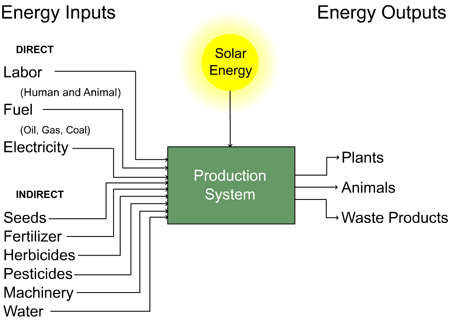Energy Efficiency
Content Page from Previous Semesters - For Reference Only
Energy efficiency is a property of agricultural systems. It is defined as the ratio of energy out to energy in. The energy out is the energy that the system outputs in the food we eat. The energy in is the energy that the system consumes in order to produce the food. Different types of agriculture systems vary widely in energy efficiency, a fact that has important implications.
Output Energy
The output energy is the energy in the food that we eat. In the United States, we typically see information about the energy content of our food expressed in units of calories. We often hear of people trying to "cut calories" in order to lose weight. However, for many people around the world, the challenge is eating enough calories in order to have the energy necessary to live and live well.

Input Energy
The input energy is the energy used to produce our food. This includes the sunlight that drives the photosynthesis performed by crop plants or plants fed to livestock animals. It includes the fossil fuels used to power farm equipment and to transport food to processing plants, restaurants, grocery stores, and our homes. It includes energy used to produce fertilizers and other resources that help crops grow.
Consider This...
Plant vs. Livestock based diets
What we eat makes a huge difference on the energy efficiency of agricultural systems. In particular, plant-based diets tend to be much more energy efficient than livestock-based diets. This is mainly because livestock animals must be fed lots of plants.
For example, when a person eats a plant about 20% of the energy within that plant will be passed on to the person to use as fuel or rebuild body tissue. The same would be true if a livestock animal eats a plant. Now, let's say that a human eats that livestock animal. There would be energy loss a second time. However, this time the energy loss involved in the animals eating plants and then humans eating the animal are combined and great reduce efficiency, or only 20% of the 20% of the energy - now that's inefficient!